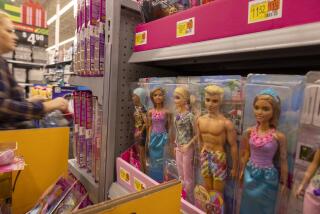Retailer Talbots’ Alterations Fit Shareholders Like a Cheap Suit
- Share via
Talbots Inc. is the latest retailer to be hurt by misjudging the changing fashion tastes of women.
Wall Street hammered Talbots’ stock on Wednesday after the retailer of classic, conservative clothing for professional and mature women disclosed several problems, all tied to a marketing shift that backfired.
The Hingham, Mass.-based chain of 566 stores is hurting from sharply lower sales at its stores that have been open at least a year, which include outlets in Pasadena, Century City, Costa Mesa and 30 other California cities. (Its total sales, now above $1 billion a year, keep rising because Talbots has aggressively opened new stores.)
The firm--which also sells its clothes, shoes and accessories via 50 million catalogs mailed each year--also said Tuesday that it expects to lose up to $12 million for its fiscal second quarter ending Aug. 2.
In addition, 50-year-old Talbots unseated its top merchandising executive and is searching for a replacement.
All of which prompted investors to dump Talbots’ shares. The stock plunged $5.94 a share to close at $23.06--a 21% loss that made it the day’s biggest percentage loser on the New York Stock Exchange.
Talbots’ blunder? The retailer shifted too far from its traditional business of selling premium-priced, classic, preppy clothes to its core base of women ages 35 to 55.
Beginning last year, it also began marketing new styles aimed at a younger audience and expanded its casual offerings. But in doing so, Talbots didn’t stock enough of its traditional items and so alienated a good portion of its core customers.
The trend turned acute in late June, when Talbots held one of its few sales events and drew a poor response. The result: a steep 7.9% drop in same-store sales (those open at least a year) for the five weeks ended Saturday.
Arnold B. Zetcher, Talbots’ chief executive, said Talbots is going back to ensuring that its merchandise is chock-full of the conventional Talbots apparel.
“There is no question we stumbled, but we are going to pull out of it in the fall,” he said in a telephone interview.”
Yet Talbots is only the latest purveyor of women’s apparel that’s struggled to keep in step with changing consumer tastes. Women are more interested in new, changing fashions than they were during the recession years of the early 1990s, and workplace changes are allowing them to wear more casual attire on the job.
That’s forced Talbots and others--including department store operator Nordstrom Inc., a key Talbots competitor, and designer Liz Claiborne Inc.--to search for the right balance so that they appeal to both younger and older consumers and offer the right mix of professional and casual clothes.
Talbots felt it needed to offer more casual lines and appeal to a younger audience. Research showed many young, working women weren’t familiar with Talbots, even as the retailer opened dozens of new stores in malls nationwide.
“We wanted to correct that,” Zetcher said. “But there probably was an overcorrection.”
Talbots’ traditional customers suddenly found they couldn’t buy many of the jackets, skirts and other clothes they’d come to expect. Talbots “went too far to bring in the new audience,” Zetcher said.
Elizabeth Pierce, apparel analyst at the regional brokerage firm Stephens Inc. in Little Rock, Ark., said she noticed the problem.
“The merchandise lacked things that I would buy for work,” she said. Talbots was founded in 1947 by Rudolph and Nancy Talbot, and they started the catalog a year later. They had only five stores when they sold the business to cereal maker General Mills Inc. in 1973.
General Mills owned it for 15 years and helped finance Talbots’ expansion to 126 stores by mid-1988 when Talbots was sold again, this time to the Japanese firm Jusco Co., which still owns 63% of Talbots’ stock.
Jusco sold a minority stake in Talbots to the public in late 1993 at $19.50 a share. But since then, the stock has gained only 33%, contrasted with the 100% surge recorded by the Standard & Poor’s 500 index.
Nonetheless, analysts noted that Talbots has assets that should support the company while it sorts out its merchandising problems. It has a strong balance sheet, a familiar brand name and a management team known for keeping costs under control, analysts said.
(BEGIN TEXT OF INFOBOX / INFOGRAPHIC)
Fashion Flaw
Talbots Inc. expects to post a loss for its fiscal second quarter after a shift in its product mix backfired. A brief look at the company:
* Headquarters: Hingham, Mass.
* Chief executive: Arnold B. Zetcher
* Employees: 2,000
* Stores: 566, accounting for 82% of 1996 sales
* Catalogs: Circulation of 50 million, accounting for 18% of 1996 sales
* 1996 sales: $1 billion
* 1996 earnings: $63.6 million
Source: Bloomberg News
More to Read
Inside the business of entertainment
The Wide Shot brings you news, analysis and insights on everything from streaming wars to production — and what it all means for the future.
You may occasionally receive promotional content from the Los Angeles Times.











